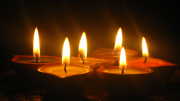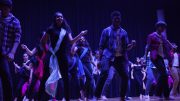A highly anticipated event, the Indian Student Association’s Diwali show concluded PME’s diversity week. Due to its popularity, the ISA planned two different shows to create more seats. As always, the program dazzled me as well as many others in the audience. The show was put together by IMSA’s ISA board consisting of Sai Talluru, Vimig Socrates, Shruthi Mothkur, Ahsan Qureshi, Renu Varadheeswaran, and Sara Nookala.
The popular dance numbers in the Diwali show were spectacular. Choreographed by Puja Mittal and Lohita Guntupalli, Girls’ Dance, was impressive with its intricate positions and wonderful use of Indian “matkas” or pots for their finale. Boys’ Dance took a different route this year. Instead of focusing on heavy choreography like previous years, Boys’ Dance was very playful and fun to watch. The sophomores’ cohesive dance choreographed by Devdhi Kasana made a strong impression for this school year’s first cultural show; we could tell they put a lot of hours into perfecting the performance. Junior Dance had a surprising turnout, as it was the biggest class dance despite the intense work schedule of junior year. Choreographers Renu Varadheeswaran, Sachi Singh, and Abrar Khaja led the juniors with catchy songs and strong performance. The show concluded with the energetic Senior Dance choreographed by Sai Talluru and Shruti Mothkur; the seniors were well in sync with each other and were very enthusiastic. Overall, the hours put into perfecting the dances were well worth it; all of the dances were very enjoyable.
In addition to the dances, there were other instrumental and singing performances. For the first time ever, IMSA’s a cappella group Mod-21 performed at the Diwali show, delivering a wonderfully executed mashup of Viva-la-Vida by Coldplay and “Jashn-E-Bahaara” by Javed Ali. The arrangement combined popular American music and Indian music, highlighting the beauty of American and North Indian styles of singing, as well as their differences and similarities.
The band also had a performance which beautifully combined American and Indian elements of Bollywood songs. The band performed the song “Tumse Milke” from the popular Bollywood film Main Hoon Na. The band had an array of different instruments, including the Indian tablas played by Saurabh Kumar, the Cuban conga drums played by Taylor Herr, as well as the popular Western stringed instruments like the violin, viola, electric guitar, and electric bass. The catchy beat of the congas and tablas and the South Asian melody sung by Nitya Pariti and Aniruddha Shekara all together created a very memorable performance.
All of the performances were brilliant, and the audience definitely enjoyed all of the unique items.
However, as an Indian-American, I felt that the ISA could have benefited from emphasizing how the program included so many different regional cultures in the show. Due to my heritage, I could easily notice the acute differences between the performance styles, but I doubt that someone experiencing Indian culture for the first time could do the same. This could have been done perhaps with better transitions in the skits, or program notes. The program notes were very limited, and the confusing skit had awkward transitions that offered no information. By making small improvements in these areas, the ISA could have done a better job of educating the audience about the huge differences and similarities in Indian culture.
For example, the event showcased three different classical Indian dances, but the program failed to make a clear differentiation between them. Sure, the program handed out indicated the different types of dances, but there was no further explanation included. The program would have benefitted from an explanation of Puja Mittal and Lajju Sudhakar’s national dance Bharatanatym, Shruthi Mothkur’s slow and expressive performance of Kuchipudi, and Vandana Karan’s rhythmic presentation of Kathak. Even though all of the dancers put so much effort into their performances, the audience’s poor awareness of each of the dances made it hard for them to understand and fully appreciate the performances.
Two juniors, Deepika Kommineni and Sanjay Kottapalli, also notably sang some popular Telugu songs, something unique in the Diwali show. In my previous years I remember students saying that they wanted to include more South Indian elements into the program, rather than just Bollywood songs. This was a huge step for ISA, but the better representation of South Indian popular culture wasn’t even addressed. The ISA just marketed the entire show as “Indian”.
Even so, ISA, the choreographers and all of the performers deserve a lot of credit for putting together such an entertaining show. Putting together a program with so many students and so many unique talents is never an easy feat to accomplish. The show had many new acts this year, many which gave the audience a better experience of the different cultures in India. This year’s Diwali show definitely included more unique features of Indian culture than any other year. The program could have however done a better job of explaining or educating its audience on the different elements of Indian culture. Nevertheless, the show was still a success, and I predict it will continue to be a success in consequent years.
Disclaimer: The opinions of those published in the Acronym are not necessarily endorsed by its editors or the publication itself.





Be the first to comment on "“Titan of the Year” – ISA Diwali Show 2013 Gets a Thumbs Up"